6 Signs A Potato Has Gone Bad
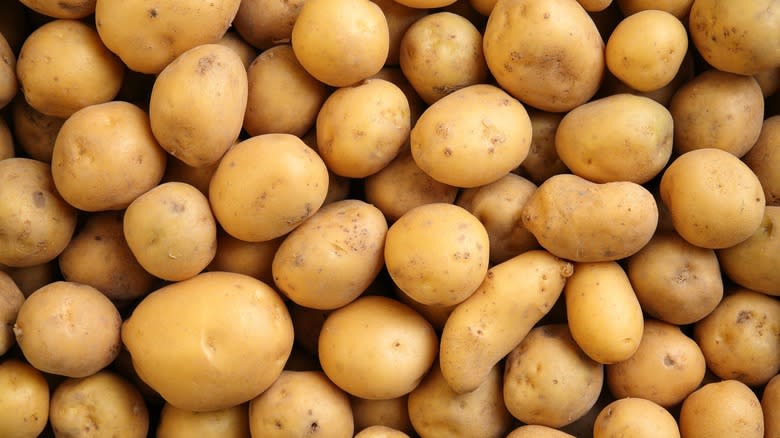
Filling and versatile, the almighty potato can be found in some form or another just about everywhere. Whether we're talking about classic oven-baked potatoes loaded up with toppings like sour cream and bacon or a crispy batch of homemade French fries, these stupendous spuds can do it all. For this reason, many of us keep a little pile of potatoes on hand in the kitchen. In fact, the average American will eat nearly 140 pounds of potatoes every year, so that pile might not be so little.
The potato's relatively long shelf life makes such bulk storage seem like a good idea. And indeed, when properly stored in a cool pantry, potatoes can last up to several months. But when stored at room temperature -- like sitting in an open basket on the kitchen counter -- they tend to only last a week or two. The vast differences between these lengths of time and the various ways that potatoes might be stored can leave you wondering if your potatoes are still safe to eat. The good news is, there are some telltale symptoms of spoilage that can clue you in. Here are six signs that a potato has gone bad.
Read more: 12 Vegetables And Fruits That Used To Look Very Different
Soft Spots
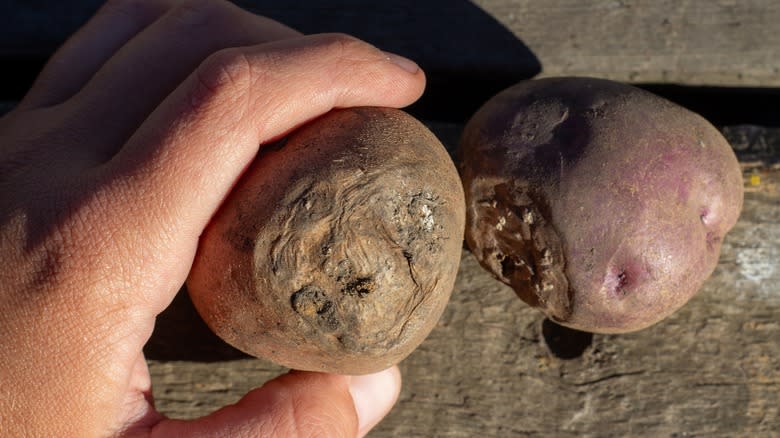
If you want to figure out if a potato has spoiled, start by picking the potato up and giving it a feel. Because potatoes are mostly composed of water, their texture fluctuates as they gradually dehydrate over time. Even though they start out extremely firm, they eventually develop soft spots as they lose the moisture that gives them structure. If you're thinking a potato in this slackened condition might give you a head start on whipping up some buttery mashed potatoes, stop -- using softened potatoes would only lead to a runny, off-tasting dish.
It's important to use all of your senses to assess the overall quality of the potato. If the soft spots are isolated to small sections of the potato and there are no bad smells or signs of mold on the skin, then there's a good chance that most of the potato can still be salvaged. Simply cut off the soft spots and use it as you wish. On the other hand, if the potato has devolved into mushiness, there are dark spots on the skin, and it smells funky, then it's definitely time to chuck it into the garbage. When in doubt, always throw it out. No potato is worth getting sick over.
Sprouts
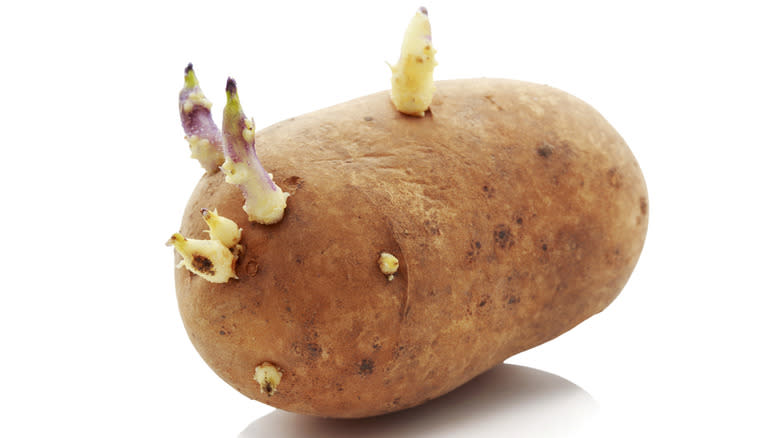
Sprouts are the little vine-like stems that emerge from a variety of plant life and vegetables, such as onions, carrots, and potatoes. When potatoes are kept at a certain temperature (around 68 degrees Fahrenheit) the conditions prime them to sprout. When sprouts are visible on potatoes, it may prompt you to believe that the potato has gone bad. But the reality is a little more complicated than that.
If the potato is still firm and the skin isn't wrinkled, then parts of the sprouted potato may still be edible -- just be sure to cut off the sprouted areas. The sprouts themselves are not edible, and they should be removed and discarded (or planted, if you have a garden -- you can regrow spuds from kitchen scraps). The key takeaway here is that if the sprouting on the potato is limited and the rest of the potato is still in good condition, then the sprouts can be properly removed and the rest of the spud may be used. But if the potato is riddled with sprouts and the skin is shriveled, then the potato is no longer edible and should be thrown away. As always, remember: It's better to be safe than sorry.
Green Skin
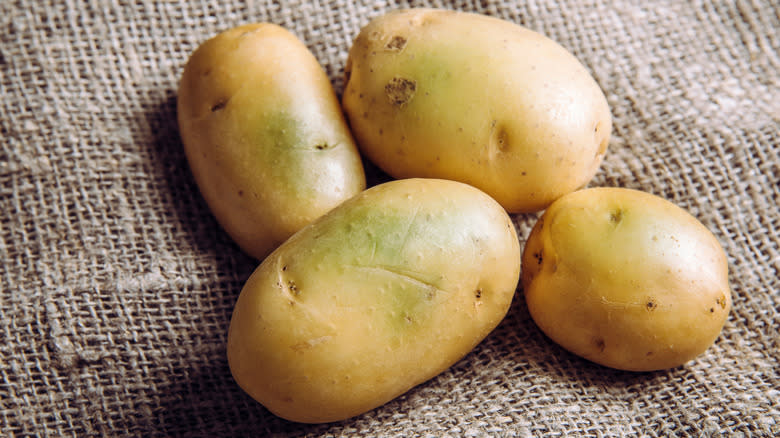
As you might imagine, a green sheen on your spuds isn't a particularly good sign. Green skin on your potatoes is most likely due to light exposure, which triggers the production of chlorophyll. The excess chlorophyll transfers to the surface of the skin, which produces a green color and can eventually lead to sprouting. The problem is, light exposure also causes that green skin to produce something called solanine, a glycoalkaloid toxin. To make matters worse, as this growth progresses, a second toxin called chocamine is also produced. Neither are very good for you.
Between the green skin and the toxins, these potatoes tend to have a bitter taste that signals something's wrong to your taste buds. If green potatoes are still somehow ingested, the toxins they carry can cause a host of unpleasant health issues such as abdominal pain, vomiting, diarrhea, and fever. Some people claim that cutting off the green skin makes the rest of the potato safe for consumption, but do you really want to risk it? Is any potato worth hovering over the toilet for? We think not.
Shriveled Skin
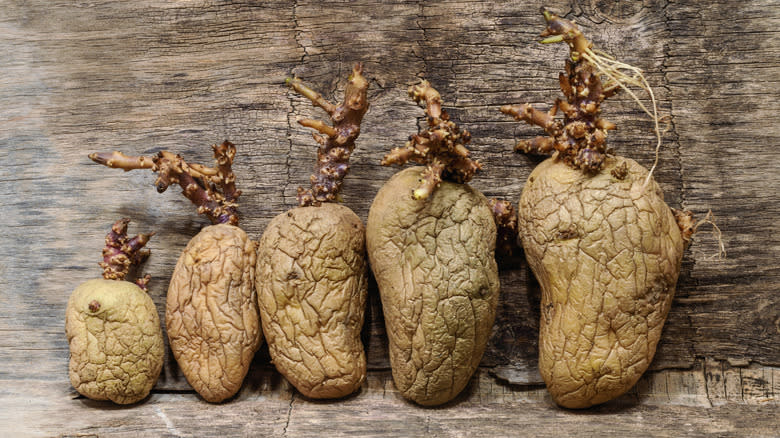
Potatoes should be firm to the touch and their skin should be tight. When the skin on a potato has become shriveled, that's a clear sign that it's spoiled. The good news is, like the other warning signs we've discussed so far, wrinkled skin is pretty easy to spot. If you see it, you know the spud's gone bad.
Even if you were to somehow not notice a potato's shriveled skin, though, you'd probably notice its bad taste and mushy texture. When potatoes shrivel, they lose a lot of their flavor and can even become sour and bitter -- one bite is all you need to know it's past its prime. In the same way that green potatoes can wreak havoc on the digestive system, potatoes with shriveled skin can also cause sickness. If you notice that your potatoes have a wrinkly texture, then it's best to just cut your losses: Those spuds are past the point of no return.
Moldy Spots
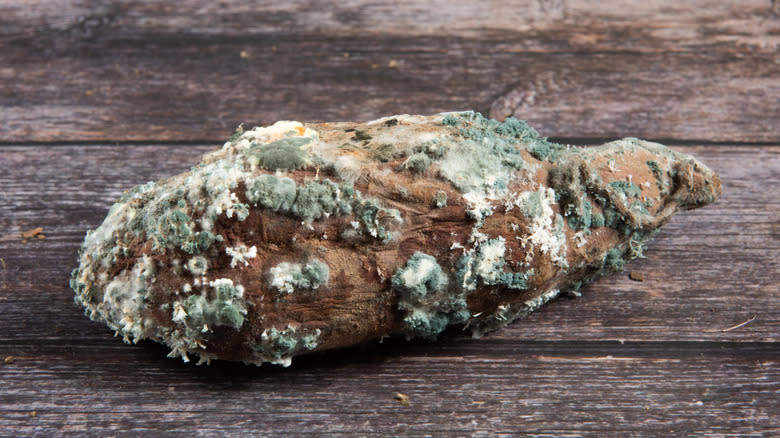
Mold is a type of fungus that appears in a variety of colors and textures. It may develop into fuzzy patches or manifest as spots on a potato's skin. If you notice that your potatoes have developed mold and you're tempted to try and somehow save them, do yourself a favor: Don't bother. Once mold has emerged on the skin of a potato, there's a good chance that there are other dangers lurking unseen, below the surface.
In some cases, the mold may be a result of the potato being infected with dry rot, which causes decay. Dry rot can cause small brown spots that tend to occur about a month after storage. These spots gradually soften and collapse, and eventually develop rings of mold. This is all a result of mycotoxins inside the potato, which pose health threats if consumed. If your gut tells you that a moldy potato is best thrown away, then you have good instincts.
Funky Smell
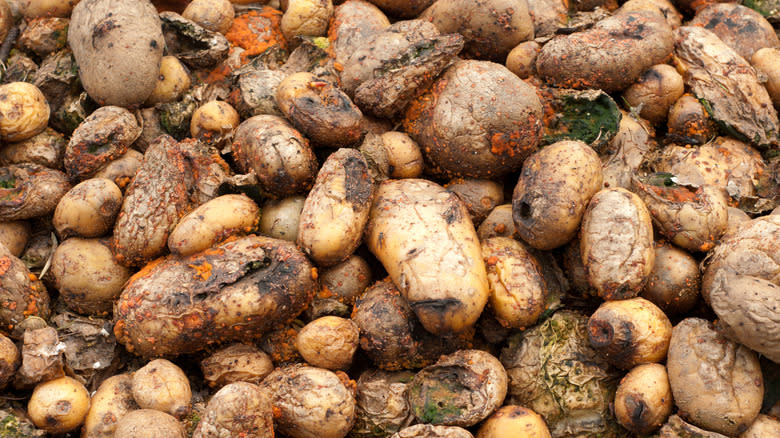
Fresh potatoes usually don't have much of a smell to them. If they smell like anything, it should be a faint earthiness. But if the smell goes beyond earthy and into outright mustiness or funk, then that's a dead giveaway that the potato has gone bad.
By the time a potato starts to stink, there are probably a bunch of other obvious warning signs available, like soft spots, mold, and wrinkly skin. Still, it's possible those visible signs are more subdued and the spoilage is mostly manifesting through scent. If you smell it, toss it out. If you aren't totally sure -- perhaps your nose isn't the best, or the smell is subtle -- cut a piece of the potato off to examine it and look for any other signs of spoilage. If the potato has become mushy or discolored, throw it away. Even if there aren't any visible signs and all you're really gauging the potato's status on is a bad smell, then it's still a good idea to consider it a goner. Our sense of smell doesn't often lead us astray. In fact, humans routinely underestimate how accurate their noses are.
Tossing a potato into the garbage is still tough, though. If you want to avoid throwing them away at all, it's best to learn how to store potatoes. With a little knowledge and prep, you can safely secure a bevy of spuds.
Read the original article on Daily Meal

